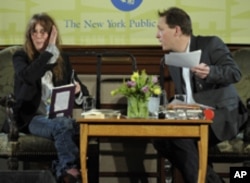A lecture series at the New York Public Library has become so popular that it often sells out in minutes. The crowds range from a few hundred to over a thousand - rock star numbers for a library program - and that's exactly the draw.
Along with Noble Laureates such as author Toni Morrison, the series includes appearances by musicians like Patti Smith, Keith Richards and Jay-Z. Movie producer John Waters has also participated. Combining music icons and Hollywood notables with celebrated authors reflects the library's new approach.
Attracting a new generation
"If libraries want to survive, it will have to find new ways to communicate with the new generation," says Paul Holdengräber, director of the popular lectures series, which is called Live from the New York Public Library. "Because of the onslaught of new modes of communication, we need more and more meeting places. I want to give people an appetite for learning. It shows people that libraries are different things. One has to create new ways of welcoming people into the library. I feel like I'm running a rock concert series to inspire people to read."
Traditionally, people use libraries for a variety of reasons. Alison Leonard, a library science student at San Jose State University, lists her uses.
"I like them because they provide a whole lot of services I want in terms of an entertainment center. I can go there for books and CDs. I can go there for inexpensive movies to rent. I can go there to look at magazines. I can rent a room and sit and write a paper and a group project. I can go there on a Saturday afternoon to read. I can get access to local newspapers."
How people use the library can also be impacted by the economy.
"Many people are going to the libraries to use computers. We are seeing a very heavy increase in usage of computers," says Audra Caplan, president of the Public Library Association. "Library uses increase during economic downturns. That was true during the Great Depression and it is true now. People are flocking to libraries to do research, find jobs, make resumes, anything that has to do with finding a job. Many times now the only way you can apply for a job is online. There are a number of unemployed people coming to fill out their forms online."
Looking ahead
Holdengräber organizes his lecture series at the New York Public Library with an eye toward the future and his success has drawn praise from his colleagues across the United States.
"I think the NYPL has done a fantastic job. One of the things they have done is they have gone after demographics that aren't traditional library users, so they are seeing the 20-to-40 age range coming in at much larger numbers than they did in the past," says Caplan. "I think a lot of it can be attributed to the larger lecture series that they have."
Leonard, the library science student, is also a librarian at East Los Angeles College. She expects the institutions to continue redefining themselves.
"It is not set in stone as to what the library will be. Our job is to respond to the user. It is not just a place for books. It is where people come together for learning. There is no subject, including rock and roll, that shouldn't be included," she says. "It can be anything from an art space, podcast studio. It can be a video filming and editing studio. It can be a blogger station. It can become a community playhouse, a gaming station for teens or for adults, anyone who enjoys games."
While libraries face challenges in engaging new generations of patrons, the experts expect them not only to survive but to thrive.
The trick, says Holdengräber, is to, "Find out what the people are interested in and give them much more."
Leonard agrees. "Libraries are forever changing. The library has been around for over 4,000 years. Whenever you do polling, people love the libraries. The library is going to respond to what the user wants and having events in the library is a great way to use the space."
Holdengräber plans to continue creating programs that surprise people. And sometimes, they surprise him in return. "We had guitar icon Keith Richards speak at the library and when he was a child, wanted to be a librarian."














